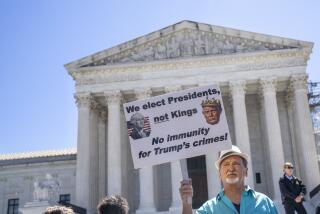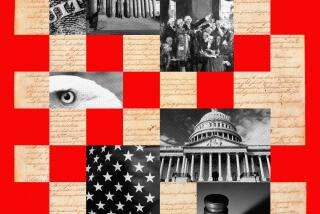Should Powers Be Realigned? : Constitution Bicentennial Spurs Debate on Revision
- Share via
WASHINGTON — The 200th anniversary of the U.S. Constitution, besides prompting celebration of its long life and good health, also has inspired serious debate over how the nation’s charter should be read and whether it should be revised.
The top lawyers of the Reagan Administration are using the occasion to advance the argument that the “original intent” of the Constitution’s framers was that elected legislators, not an unelected Supreme Court, would decide the most sensitive legal questions.
In his speeches, Atty. Gen. Edwin Meese III has quoted James Madison, Alexander Hamilton and Thomas Jefferson, among others, to support his contention that the authors of the Constitution did not envision the high court taking as active a role as it has in recent years on controversial issues such as abortion law and prayer in schools.
And, as Meese expresses his worries about power concentrated in the hands of the court, a bipartisan group of Washington lawyers and politicians is voicing concern about insufficient power and accountability in the other two branches of government. This group sees a stalemate in the government and holds that the Constitution’s separation of powers in recent decades has resulted in a serious new problem: too much separation and not enough power.
To correct this, they propose constitutional revisions that would move American government closer to the British parliamentary system, in which the head of the majority party controls both the legislative and the executive branches.
Scholars say that this current clash of ideas is the most fitting celebration of the Constitution, because the document emerged from a unique ideological battle over how best to structure a democratic government.
“We hope this bicentennial year will be a springboard for continuing debate and study about our system, including its shortcomings,” said Prof. James MacGregor Burns of Williams College in Massachusetts. He has advocated making what he calls “modest changes” in the Constitution.
The nation’s first government--the Articles of Confederation--took only a few years to prove its shortcomings. The Continental Congress had little power over the states or the people, and it could not use what authority it had because there was no executive to enforce the laws it made.
Recognizing the feeble, flawed character of that system, James Madison went to the convention in Philadelphia in May, 1787, with a plan for a three-branch government in which Congress would write the laws, a President would enforce them and a Supreme Court would decide “cases or controversies” involving those laws.
Critical of Warren Court
Meese argues, however, that since Earl Warren became chief justice in 1953, the Supreme Court has abandoned the role of constitutional interpreter and has instead begun to shape social policy. “The court’s opinions were, on the whole, more policy choices than articulations of constitutional principle,” Meese said of recent rulings.
To combat this politicization of the court, Meese said, the Reagan Administration urges the justices to decide cases based on the “original meaning of the constitutional provisions.”
Critics of the attorney general contend, however, that he is more interested in contemporary politics than constitutional history. And some historians say that Meese has misstated the intentions of the framers.
Supreme Court Justice William J. Brennan Jr., a 30-year veteran of the court and its steadiest liberal, attacked Meese’s advice that the justices should rely on “original intent.” He called it “little more than arrogance cloaked as humility. It is arrogant to pretend that, from our vantage, we can gauge accurately the intent of the framers on application of principle to specific, contemporary questions,” Brennan said in a 1985 speech.
Moreover, Justice John Paul Stevens has pointed out, Meese’s speeches often conveniently overlook the Civil War and the three constitutional amendments that followed it. In the view of most scholars, it was those amendments--not the Supreme Court--that turned the constitutional balance away from the states and toward centralized power.
Rights Protected Further
For example, the first 10 amendments--known as the Bill of Rights--say that Congress may not restrict certain rights, such as the freedom of speech. The post-Civil War amendments, rather than citing the federal government, say specifically that the states may not limit those rights.
Before the war, states could legally discriminate against blacks. The 14th Amendment, adopted after the war in 1868, says that “no state” may deny its citizens “the equal protection of the laws.” The other postwar amendments ended slavery and gave blacks the right to vote.
Many historians also doubt the validity of Meese’s claim that the founding fathers wanted to leave most powers in the hands of state legislators. In fact, they say, Madison’s view was just the opposite.
“The idea that claims to individual rights could be safely left to the judgment of majorities--especially state majorities--runs directly contrary to everything that Madison thought at the time the Constitution was adopted,” Stanford University history professor Jack N. Rakove wrote recently in Atlantic magazine.
Madison wrote at the time that the “real source of danger” in America was the “powerful tendency in the legislature to absorb all power into its vortex.” In addition, Rakove says, Madison would have “opposed the current conservative cry that judges should simply decide cases, not make policy.”
Some Agree With Meese
Still, other scholars who have examined the writings of the Constitution’s framers side more with Meese.
“If you look at the founding documents, you can see they assumed policies would be made by the popular branches, not the judiciary,” said Ralph Rossum, a professor of government at Claremont McKenna College in California. “I tend to be suspicious of an activist judiciary, because we can’t correct what those nine attorneys decide. If a popular branch goes wrong, the public can correct it.”
In the most controversial cases of recent terms, the Supreme Court has struggled with the question of how much to limit the powers of state legislatures.
Meese and other conservatives say that the states should be permitted to regulate abortion and homosexual activity, for example, because these are not mentioned as protected rights in the Constitution. This view is shared by Chief Justice William H. Rehnquist and Justice Byron R. White, who last term wrote a court opinion upholding Georgia’s law against sodomy.
Many scholars say this narrow view of the Bill of Rights does not reflect the original intention of the founders.
‘Powers as Islands’
“When conservatives . . . treat rights as islands surrounded by a sea of government powers, they precisely reverse the view of the founders as enshrined in the Constitution, wherein government powers are limited and specified and rendered as islands surrounded by a sea of individual rights,” Steven Macedo, professor of government at Harvard University, wrote in an essay for the libertarian Cato Institute in Washington.
While Meese and liberals disagree over what the high court has decided, a group of Washington attorneys and politicians--known as the Committee on the Constitutional System--worries when the government fails to decide. As an example, they cite the huge federal budget deficit, a perennial problem because neither the executive nor the legislative branch wants to take the political risks that come with cutting spending or raising taxes.
Each branch tends to blame the other for the problem. And, the committee members say, the same could be said of other issues, such as arms control, policy on Central America, the trade deficit or energy policy.
Partisan Divisions Cited
“The difficulty lies mainly in the diffuse structure of the executive-legislative process and in the decline of party loyalty,” said a report released last month by the 48 members of the bipartisan group, whose leaders include Prof. Burns, Sens. Nancy Landon Kassebaum (R-Kan.) and Daniel Patrick Moynihan (D-N.Y.) and former White House counsel Lloyd Cutler.
The problem of “divided government,” they add, is of recent vintage. From 1789 until World War II, the White House and a congressional majority were in the hands of different parties less than 25% of the time. Since 1968, however, the government has been so divided 80% of the time, the report says.
Such division, the group notes, is not possible under Britain’s form of government. “We’re attracted to the strong collective leadership system, such as in the British Cabinet,” Burns said.
To “encourage party cohesion” in the United States and “lessen deadlock between the executive and legislative branches,” the committee proposes a variety of constitutional changes. These range from permitting members of Congress to serve in the Cabinet to extending House terms to four years to coincide with presidential elections.
Burns says that he and the committee hope for debate, not enactment, of their proposals this year:
“At some point in the next decade or two, there will be enormous pressure to change the American political system, probably because of a crisis,” he said. “Then, when the need for change is clear, the ideas will have been well debated. The homework will have been done.”
More to Read
Sign up for Essential California
The most important California stories and recommendations in your inbox every morning.
You may occasionally receive promotional content from the Los Angeles Times.











